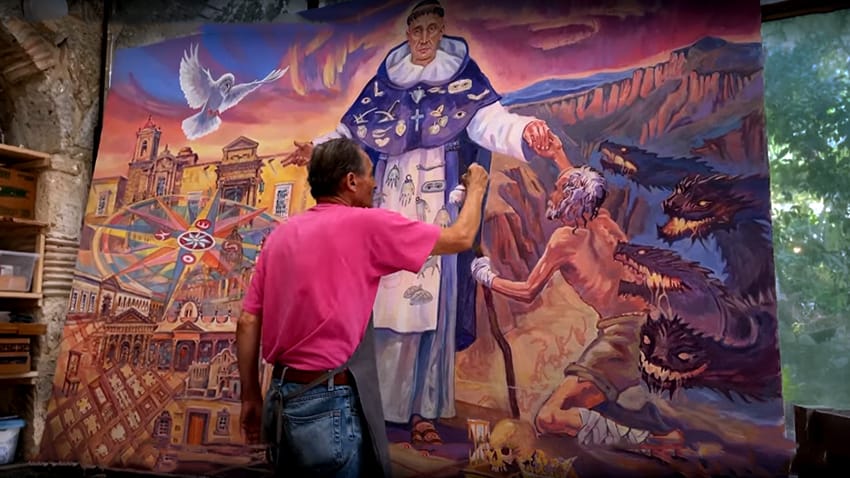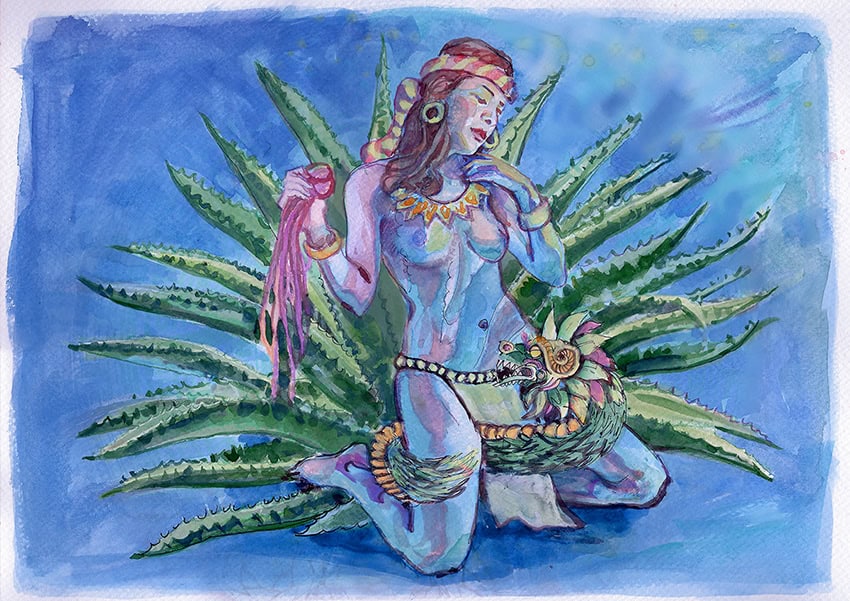Guadalajara’s twenty-seventh Festival Cultural de Mayo was inaugurated on May 2 with an exhibition of “Acuarelas Ancestrales” (ancestral watercolors) painted by local muralist Jorge Monroy. The paintings will be on display at Casa Feria in the city’s historic center, throughout the month of May.
I visited Monroy at his rustic studio in the foothills of the Primavera Forest, just west of Guadalajara. As the painter picked tomatoes from his garden, he described the watercolors he had chosen for this event.

“I am presenting 18 originals,” he told me “all with the theme of pre-Hispanic Jalisco. This includes circular pyramids, shaft tombs, obsidian, the ancient ball game Ulama and scenes of everyday life 2,000 years ago.”
Maize: made in Mexico
In these scenes of daily life, Monroy gives special importance to maíz (corn).
“The most important painting for this event,” the artist told me, “shows a woman lovingly caring for a maize plant with a view of the Great Lake of Magdalena (drained by the Spaniards) in the background. You can see their colorful houses in the distance and people planting corn. This is a scene that could have taken place 3,000 years ago.”
The process of breeding maize, in fact, started much earlier than that, perhaps as long as 9,000 years ago.
“The domestication of corn took place in Mexico and there is some evidence that it may have occurred right here in what we now call Jalisco,” the painter told me. “This, I consider Mexico’s most important contribution to humanity because today maize is the most cultivated food on the planet. Our ancestors started out as hunters and gatherers, nomads, but then they came upon a grass that they called teocintle and they began to cultivate and domesticate it.”

Domestication, Monroy pointed out, required saving seeds from plants with the biggest, best and most kernels. “This they did year after year,” he says, “and created corn as we know it today. Originally, teocintle had only about 12 kernels, hard enough to break your teeth. Compare that to what we call maíz today!”
Secrets of the shaft tomb
In another of his watercolors, Monroy takes us inside a shaft tomb, a peculiar tradition of West Mexico that was in vogue from around 300 B.C. to 400 A.D.
“In this painting,” said Monroy, “I have recreated a ceremony that must have taken place inside all the shaft tombs: what we think of today as a funeral. They had special ceramics for this occasion and a whole host of items that would be buried alongside the corpse, things representing the deceased’s tastes and preferences.”
The shaft tombs were deep holes, just over a meter wide, dug into the soft volcanic tuff so common in West Mexico.
With one to three burial chambers at the bottom, the shaft might have been two to 22 meters deep, perhaps a kind of insurance policy meant to protect the tombs from looting. Unfortunately, this strategy has not dissuaded modern tomb raiders, who have beaten the archaeologists to the bottom of almost every shaft tomb known.

Fortunately, in 1993 an untouched tomb was found at Huizilapa, Jalisco, located just northwest of Tequila.
This shaft was 7.6 meters deep and had two chambers. Six individuals were found, three in each chamber, together with rich offerings. The body of the most important individual in the tomb was, according to archaeologist Eduardo Williams, “elaborately adorned with jade and shell bracelets, nose-rings, earrings, greenstone beads, carved jade pendants and a cloth sewn with thousands of shell beads. Conch shells ornamented with painted stucco had been placed on his loins and at his sides, along with atlatl hooks.”
Incredible as it may sound, over 60,000 artifacts were discovered inside the Huitzilapa tomb.
Pre-Hispanic restaurant
Jorge Monroy’s new collection of paintings will be on display in Guadalajara’s Casa Feria, which hosts cultural events including concerts, plays and book launches. Casa Feria is also a restaurant — open only on weekends — specializing in pre-Hispanic food. This means that visitors to the painting exhibit can wander about, immersing themselves in a world of ancient customs and after that, enjoy a pre-Hispanic meal.

From Beethoven to Jazz
The watercolor exhibit is just the first of many events taking place in Guadalajara throughout May.
On May 7, 8 and 9, the city will celebrate the 200th anniversary of the premiere performance of Beethoven’s Ninth Symphony. On these nights the “Choral Symphony” will be played at the city’s celebrated Degollado Theatre, followed by all of Beethoven’s 32 sonatas between the 12th and 23rd of May, at the same venue.
Dozens of other cultural activities will take place throughout the rest of the month, everything from 3D Street Art and a concert by the GRAMMY-winning Attacca Quartet to the premiere of a “Jalisco Jazz Suite” by Guadalajara’s Arturo de la Torre Jazz Orchestra.
To learn about all 34 cultural events taking place in and around Guadalajara during the month of May, see the official page of the Festival Cultural de Mayo en Jalisco.
John Pint has lived near Guadalajara, Jalisco, for more than 30 years and is the author of A Guide to West Mexico’s Guachimontones and Surrounding Area and co-author of Outdoors in Western Mexico. More of his writing can be found on his website.
